ISSN ONLINE(2278-8875) PRINT (2320-3765)
ISSN ONLINE(2278-8875) PRINT (2320-3765)
Abhishek Chaturvedi1, V. K. Tripathi2, T Vijay Muni3, Neeraj Singh4
|
| Related article at Pubmed, Scholar Google |
Visit for more related articles at International Journal of Advanced Research in Electrical, Electronics and Instrumentation Engineering
This paper presents the concept of simultaneous ac-dc power transmission. Long extra high voltage (EHV) ac lines cannot be loaded to their thermal limits due to this instability occurs in the power system. It is difficult to load long extra high voltage (EHV) ac lines to their thermal limits as a sufficient margin is kept against transient instability. With the model proposed in this thesis, it will be possible to load these lines close to their thermal limits. The transmission lines are allowed to carry usual ac along with dc superimposed on it. The conductors are allowed to carry usual ac along dc superimposed on it. This thesis gives us the feasibility of converting a double circuit ac line into composite ac–dc power transmission line to get the advantages of parallel ac–dc transmission in order to transient stability and dynamic stability and dampen out oscillations. Simulation has been carried out in MATLAB software package (Simulink Model). The results show the stability of power system both for natural response when compared with only ac transmission.
Keywords |
| EHV transmission, (FACTS), HVDC, MAT Lab, Simultaneous ac-dc transmission, Power System Stability. |
I. INTRODUCTION |
| This paper presents a simple scheme of simultaneous EHV ac-dc power flow through the same transmission line with an object to achieve the advantages of parallel ac-dc transmission. Simultaneous ac dc transmission may also claim advantages in some specific applications LV (low voltage) and MV (Medium voltage) system. For HVDC Transmission line in recent years, environmental, right-of-way (Row) and economic concerns have delayed the construction of a new transmission line. The demand of electric power has shown steady growth but geographically it is quite uneven. The power is often not available at the growing load centres but at remote locations. Often the regulatory policies, environmental acceptability, and the economic concerns involving the availability of energy are the factors determining these locations. Now due to stability considerations, the transmission of the available energy through the existing ac lines has an upper limit. Thus, it is difficult to load long extra high voltage (EHV) ac lines to their thermal limits as a sufficient margin is kept against transient instability & dynamic stability as well as to damp out oscillations in power system. The present situation demands for the fact that there is full utilization of available energy applying the new concepts to the traditional power transmission theory keeping in view the system availability and security. |
| FACTS concepts is based on the application of power electronic technology to the existing ac transmission system, this improves stability to achieve power transmission close to its thermal limit. Very fast control of SCRs in FACTS devices like state VAR system SVS, CSC, SPS and controlled braking resistors oscillations as well as to control the voltage profile of the line by controlling the total reactive power flow. Only the basic idea is proposed along with the feasibility study using elementary laboratory model. Simultaneous ac–dc power transmission was earlier proposed through a single circuit ac transmission line i.e. uni-polar dc link with ground as return path was used. The limitations of ground as return path is due to the fact that the use of ground may corrode any metallic material if it comes in its path. The instantaneous value of each conductor voltage with respect to ground becomes higher due to addition of dc voltage, hence more discs have to be added in each insulator string so that it can withstand this increased voltage. The conductor separation distance was kept constant, as the line-to-line voltage remains unchanged. This thesis gives us the feasibility of converting a double circuit ac line into composite ac–dc power transmission line without altering the original line conductors, insulator strings and tower structures. |
II. CONCEPT OF SIMULTANEOUS AC-DC TRANSMISSION |
| The circuit diagram in Figure1 shows the basic scheme for simultaneous ac-dc transmission. The dc power is obtained through the rectifier bridge and injected to the neutral point of the zigzag connected secondary end transformer, and again it is reconverted to ac by the inverter bridge at the receiving end. The inverter bridge is again connected to the neutral of zigzag connected winding of the receiving end transformer. Fig. 1 depicts the basic model for simultaneous ac-dc power flow through a dual circuit ac transmission line. Line commutated 12-pulse rectifier bridge is used in conventional HVDC and the dc power is injected to the neutral point of the zig-zag connected secondary of sending end transformer and is recovered back to ac again by the line commutated 12-pulse bridge inverter at the receiving end side. |
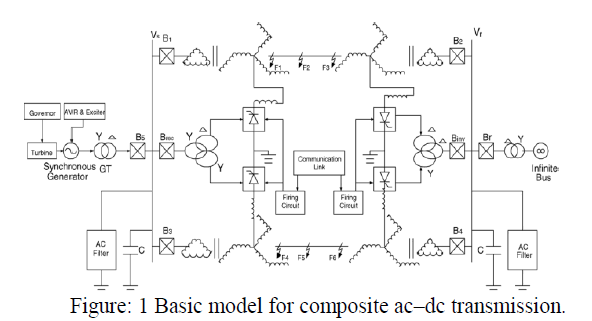 |
| The inverter bridge is also connected to the neutral of zig-zag connected winding of the receiving end transformer to recover back the dc current to the inverter. The dual circuit ac transmission line carriers both three-phase ac and dc power. Each conductor of each transmission line carries one third of the total dc current with ac current superimposed. Since the resistance is equal in all the three phases of secondary winding of zig-zag transformer and the three conductors of the line, the dc current is equally divided in all the three phases. The conductor of the second transmission line provides return path for the dc current to flow. The saturation of transformer due to dc current can be removed by using zig-zag connected winding at both ends. The fluxes produced by the dc current (Id / 3) flowing through each winding of the core of a zig-zag transformer have equal magnitude and opposite in direction and hence cancel each other. At any instant of time the net dc flux becomes zero. Thus, the dc saturation of the core is removed. A reactor Xd with higher value is used to reduce harmonics in dc current. In the absence of third order harmonics or its multiple and zero sequence, under normal operating conditions, the ac current flow through each transmission line gets restricted between the zig-zag connected windings and the conductors of the transmission line. The presence of these components may only be able to produce negligible current through the ground due to higher value of Xd. |
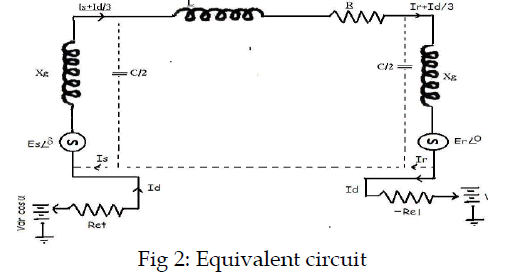 |
| Assuming the usual constant current control of rectifier and constant extinction angle control of inverter, the equivalent circuit of the scheme under normal steady state operating condition is shown in Fig.2. The dotted line in the figure shows the path of ac return current only. Each conductor of the line carries (Id / 3) along with the ac current per phase and the maximum values of rectifier and inverter side dc voltages are Vdro and Vdio respectively. The line parameters per phase of each line R, L and C. Rcr and Rci are the commutating resistances, and, α is the firing angle and γ is the extinction angles of rectifier and inverter. The ground carries the full dc current Id only and each conductor of the line carries Id/3 along with the ac current per phase The expressions for ac voltage and current and the power equations in terms of A, B, C and D parameters of each line when the resistive drop in transformer winding and in the line conductors due to dc current are neglected can be written as |
| Sending end voltage: |
 |
| The expressions for dc current and the dc power, when the ac resistive drop in the line and transformer are neglected, |
| Dc current: |
| Id = (Vdrcosα - Vdicosγ)/(Rer+(R/3) – Rci) (5) |
| Power in inverter: |
| Pdi = Vdi x Id (6) |
| Power in rectifier: |
| Pdr = Vdr x Id (7) |
| Where R is the line resistance per conductor, Rcr and Rci commutating resistances, α and γ, firing and extinction angles of rectifier and inverter respectively and Vdr and Vdi are the maximum dc voltages of rectifier and inverter side respectively. Values of Vdr and Vdi are 1.35 times line to line tertiary winding ac voltages of respective sides. Reactive powers required by the converters are: |
| Qdi = Pdi tanθI (8) |
| Qdr = Pdr tanθr (9) |
| CosθI = (cosγ + cos (γ + μi))/2 (10) |
| Cosθr = (cosα + cos (α + μr))/2 (11) |
| Where μI and μr are commutation angles of inverter and rectifier respectively and total active and reactive powers at the two ends are |
| Pst = Ps + Pdr and Prt = PR + Pdi (12) |
| Qst = Qs + Qdr and Qrt = QR + Qdi (13) |
| Total transmission line loss is: |
| PL = (Ps + Pdr) – (PR + Pdi) (14) |
| Ia being the rms ac current per conductor at any point of the line, the total rms current per conductor becomes: |
| I = sqrt (Ia2 + (Id/3)2) and PL 3I2R |
| If the rated conductor current corresponding to its allowable temperature rise is Ith and |
| Ia = X * Ith; X being less than unity, the dc current becomes: |
| Id = 3 x (sqrt (1-x2)) Ith |
| The total current I in any conductor is asymmetrical but two natural zero-crossings in each cycle in current wave are obtained for (Id/3Ia) <1.414. |
| The instantaneous value of each conductor voltage with respect to ground becomes the dc voltage Vd with a superimposed sinusoidally varying ac voltages having rms value Eph and the peak value being: Emax = V + 1.414 Eph Electric field produced by any conductor voltage possesses a dc component superimposed with sinusoidally varying ac component. But the instantaneous electric field polarity changes its sign twice in cycle if (Vd/Eph)<1.414.Therefore, higher creepage distance requirement for insulator discs used for HVDC lines are not required. Each conductor is to be insulated for Emax but the line to line voltage has no dc component and ELL(max) = 2.45 Eph. |
| Therefore, conductor to conductor separation distance is determined only by rated ac voltage of the line. Assuming Vd/Eph = k |
| Pdc/’Pac # (Vd * Id)/(3* Eph*Ia*cosT) =(k *sqrt(1-x2))/(x*cosT) (17) |
| Total power |
| Pt = Pdc + Pac = (1+ [k * sqrt (1-x2)]/(x * cosT)) * Pac (18) |
| Detailed analysis of short current ac design of protective scheme, filter and instrumentation network required for the proposed scheme is beyond the scope of present work, but preliminary qualitative analysis presented below suggests that commonly used techniques in HVDC/ac system may be adopted for this purposes. In case of fault in the transmission system, gate signals to all the SCRs are blocked that to the bypass SCRs are released to protect rectifier and inverter bridges. CBs are then tripped at both ends to isolate the complete system. As mentioned earlier, if (Id3Ia) <1.414, CBs connected at the two ends of transmission line interrupt current at natural current zeroes and no special dc CB is required. To ensure proper operation of transmission line CBs tripping signals to these CBs may only be given after sensing the zero crossing of current by zero crossing detectors. Else CB’s connected to the delta side of transformers (not shown in figure1) may be used to isolate the fault. Saturation of transformer core, if any, due to asymmetric fault current reduces line side current but increases primary current of transformer. Delta side CBs designed to clear transformers terminal faults and winding faults, clear these faults easily. |
| Proper values of ac and dc filters as used in HVDC system may be connected to the delta side and zigzag neutral respectively to filter out higher harmonics from dc and ac supplies. However, filters may be omitted for low values of Vd and Id. At neutral terminals of zigzag winding dc current and voltages may be measured by adopting common methods used in HVDC system. Conventional cvts as used in EHV ac lines are used to measure ac component of transmission line voltage. Superimposed dc voltage in the transmission line does not affect the working of cvts. Linear couplers with high air-gap core may be employed for measurement of ac component of line current as dc component of line current is not able to saturate high air-gap cores. Electric signal processing circuits may be used to generate composite line voltage and current wave-forms from the signals obtained for dc and ac components of voltage and current. Those signals are used for protection and control purposes. |
III. SELECTION OF TRANSMISSION VOLTAGE |
| The instantaneous value of each conductor voltage with respect to ground becomes more in case of simultaneous acdc transmission system by the amount of the dc voltage superimposed on ac and more discs are to be added in each string insulator to withstand this increased dc voltage. However, there is no change required in the conductor separation distance, as the line-to-line voltage remains unaltered. Therefore, tower structure does not need any modification if same conductor is used. Another possibility could be that the original ac voltage of the transmission be reduced as dc voltage is added such that peak voltage with respect to ground remains unchanged. Therefore, there would be no need to modify the towers and insulator strings. |
| a)Controllability of Power Systems To illustrate that the power system only has certain variables that can be impacted by control, we have considered here the power-angle curve, shown in Figure 3. Although this is a steady-state curve and the implementation of FACTS is primarily for dynamic issues, this illustration demonstrates the point that there are primarily three main variables that can be directly controlled in the power system to impact its performance. |
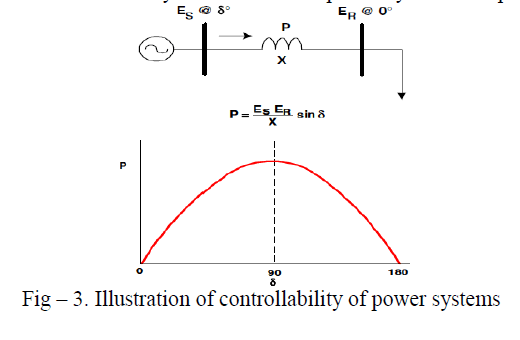 |
| These are: |
| • Voltage |
| • Angle |
| • Impedance |
| We can also infer the point that direct control of power is a fourth variable of controllability in power systems. With the establishment of âÃâ¬Ãâ¢whatâÃâ¬Ãâ variables can be controlled in a power system, the next question is âÃâ¬Ãâ¢howâÃâ¬Ãâ these variables can be controlled. The answer is presented in two parts: namely conventional equipment and FACTS controllers. |
| Examples of Conventional Equipment For Enhancing Power System Control |
| • Series Capacitor -Controls impedance |
| • Switched Shunt-Capacitor and Reactor - Controls voltage |
| • Transformer LTC -Controls voltage |
| • Phase Shifting Transformer -Controls angle |
| • Synchronous Condenser -Controls voltage |
| • Special Stability Controls-Focuses on voltage control but often include direct control of power |
| Example of FACTS Controllers for Enhancing Power System Control |
| • Static Synchronous Compensator (STATCOM) -Controls voltage |
| • Static VAR Compensator (SVC) -Controls voltage |
| • Unified Power Flow Controller (UPFC) |
| • Inter-phase Power Flow Controller (IPFC) |
| • Static Synchronous Series Controller (SSSC) Each of the above mentioned controllers have impact on voltage, impedance and/or angle (and power) |
| • Thyristor Controlled Series Compensator (TCSC)-Controls impedance |
| B) Benefits of utilizing FACTS devices |
| The benefits of utilizing FACTS devices in electrical transmission systems can be summarized as follows |
| •Better utilization of existing transmission system assets |
| •Increased transmission system reliability and availability |
| •Increased dynamic and transient grid stability and reduction of loop flows |
| •Increased quality of supply for sensitive industries |
| •Environmental benefits Better utilization of existing transmission system assets |
IV. PROPOSED APPLICATIONS |
| 1. Long EHV ac lines cannot be loaded to their thermal limit to keep sufficient margin against transient instability and to keep voltage regulation within allowable limit, the simultaneous power flow does not imposed any extra burden on stability of the system, rather it improves the stability. The resistive drop due to dc current being very small in comparison to impedance drop due to ac current, there is also no appreciable change in voltage regulation due to superimposed dc current. |
| 2. Therefore one possible application of simultaneous ac-dc transmission is to load the line close to its thermal limit by transmitting additional dc power. Figure4 shows the variation of Pt/Pac for changing values of k and x at unity power factor. However, it is to be noted that additional conductor insulation is to be provided due to insertion of dc. |
| 3. Necessity of additional dc power transmission will be experienced maximum during peak load period which is characterized with lower than rate voltage. If dc power is injected during the peak loading period only with V d being in the range of 5% to 10% of E ph, the same transmission line without having any enhanced insulation level may be allowed to be used For a value of x=0.7 and V d =0.05 E ph or 0.10 E ph, 5.1% or 10.2% more power may be transmitted. |
| 4. By adding a few more discs in insulator strings of each phase conductor with appropriate modifications in crossarms of towers insulation level between phase to ground may be increased to a high value, which permits proportional increase in Emax, Therefore higher value of Vd may be used to increase dc and total power flow through the line. This modification in the exiting ac lines is justified due to high cost of a separate HVDC line. |
| 5. Control of D and J also controls the rectifier and inverter VAR requirement and therefore, may be used to control the voltage profile of the transmission line during low load condition and works as inductive shunt compensation. It may also be considered that the capacitive VAR of the transmission line is supplying the whole or part of the inductive VAR requirement of the converter system. In pure HVDC system capacitance of transmission line cannot be utilized to compensate inductive VAR. |
| 6. The independent and fast control of active and reactive power associated with dc, superimposed with the normal ac active and reactive power may be considered to be working as another component of FACTS. |
| 7. Simultaneous ac-dc power transmission may find its application in some special cases of LV and MV distribution system. When 3-phase power in addition to dc power is supplied to a location very near to a furnace or to a work place having very high ambient temperature, rectification of 3-phase supply is not possible at that location using semiconductor rectifier. In such place simultaneous ac-dc transmission is advantageous. In air craft 3-phase loads are generally fed with higher frequency supply of about 400Hz and separate line is used for dc loads. Skin effect restricts the optimum use of distribution wires at high frequency. Simultaneous ac-dc power transmission reduces both volume and weight of distributors. |
V. EXPERIMENTAL VERIFICATION |
| The feasibility of the basic scheme of simultaneous ac-dc transmission was verified in the laboratory. Transformer having a rating of 2 kVA, 400/230/110V are used at each end. A supply of 3-phase, 400V, 50Hz are given at the sending end and a 3-phase, 400 V, 50 Hz,1 HP induction motor in addition to a 3-phase, 400V, 0.7 KW resistive load was connected at the receiving end. A 10 A, 110 Vdc reactor (Xd) was used at each end with the 230V zigzag connected neutral. Two identical SCR bridges were used for rectifier and inverter. The dc voltages of rectifier and inverter bridges were adjusted between 145 V to135 V to vary dc current between 0 to 3A. The same experiment was repeated by replacing the rectifier at the sending and and the inverter at receiving end by 24V battery and a 5A, 25 rheostat respectively, between Xd and ground. The power transmission with and without dc component was found to be satisfactory in all the cases. To check the saturation of zigzag connected transformer for high value of Id, ac loads were disconnected and dc current was increased to 1.2 times the rated current for a short time with the input transformer kept energized from 400V ac. But no changes in exciting current and terminal voltage of transformer were noticed verifying no saturation even with high value of Id. |
VI. SIMULATION RESULTS AND DISCUSSION |
| The loadability of Moose (commercial name), ACSR, twin bundle conductor, 500-kV, 60-Hz, 600-km double circuit line has been computed. The sending and receiving end currents rises to a certain spike and then recovers gradually. In general the voltage of across the rectifier and inverter dips on the occurrence of fault whereas the current level spikes under fault conditions. The above results are obtained by using a Double line to ground fault in the distributed parameters for the double circuit line model. Under fault conditions the reactive power requirement increases as can be inferred from the graph. As the reactive power is utilized in the circuit hence the reactive power at the receiving end side is lowered to a negative value for example the voltage profile or the current or the sudden surge in the reactive power requirement has inherent sluggishness, the system requires a long time to recover. But by using the simultaneous ac-dc model the transient response is increased and hence the transient stability. |
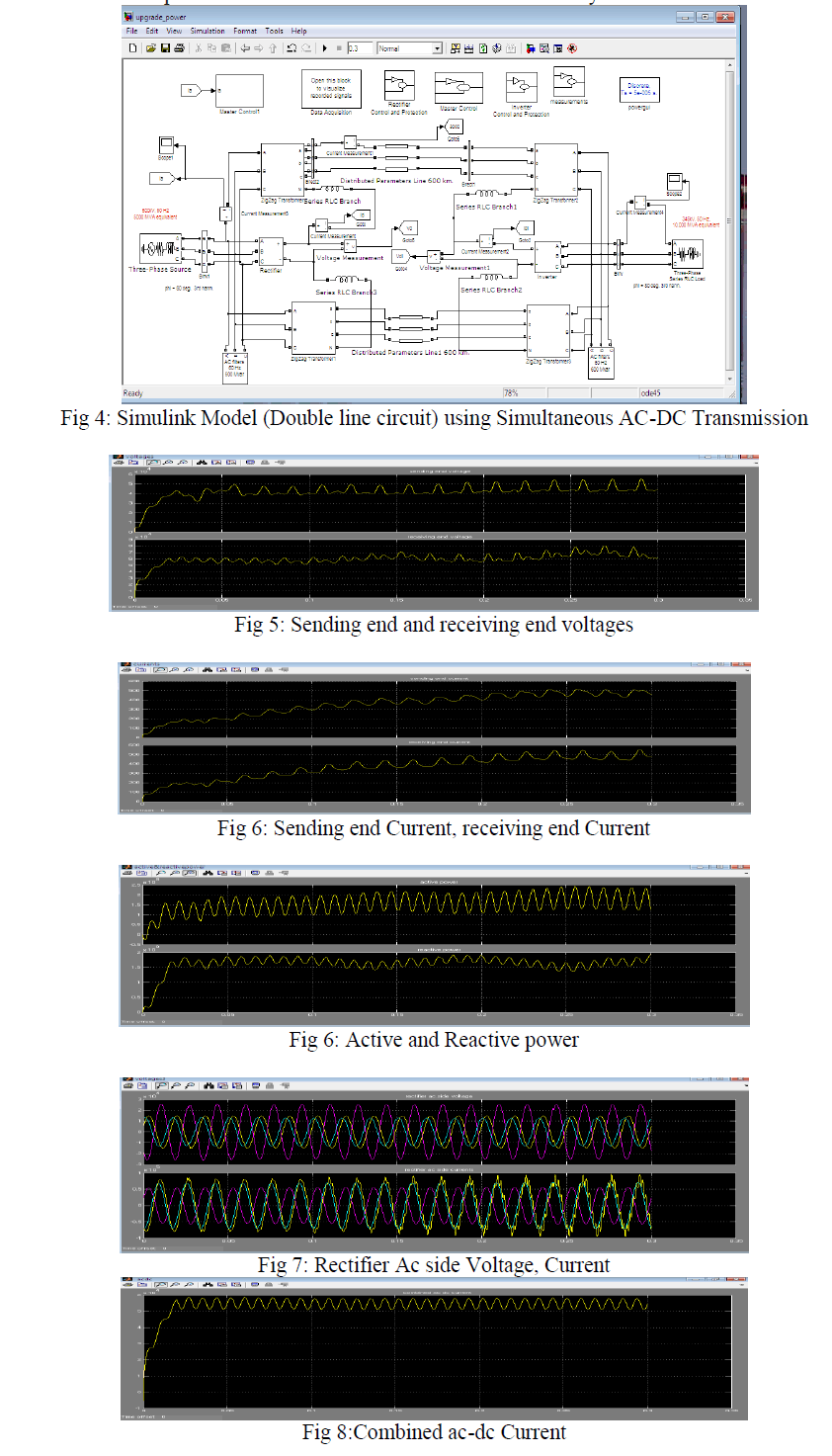 |
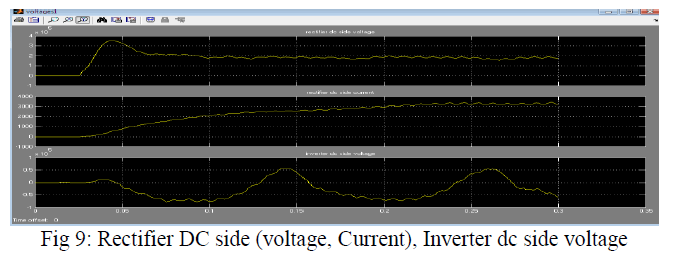 |
| The stability is further enhanced because of quicker current control mechanism of HVDC blocks that is the rectifier and inverter blocks. In the control mechanism there is a master control and separately there is inverter and rectifier protection which works on VDCOL control procedures. Whenever the voltage dips on occurrence of a fault the current is restricted so the fault current is also decreased and the most significant thing is that it has very small time constant that is it works very fast. |
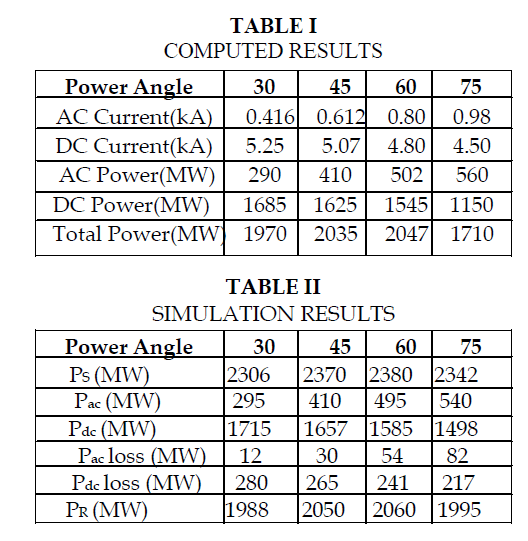 |
VII. CONCLUSION |
| A simple scheme of simultaneous EHV ac-dc power transmission through the same transmission line has been presented. Expressions of active and reactive powers associated with ac and dc, conductor voltage level and total power have been obtained for steady state normal operating condition. The EHV ac lines, because of inherent transient stability problem cannot be loaded to their maximum thermal limit. Here the conductors are carrying superimposed dc current with ac current. The added dc power flow is flawless and is not the cause of any transient instability. This thesis shows the possibility of converting a dual circuit ac line into simultaneous ac-dc power transmission block to improve power transfer as well as to achieve reliability in the power transfer. There is no physical alteration in insulator strings, towers and arresters of the original line .There is substantial gain in the loading capability of the line .There is a master controller which controls the overall current that is flowing in the lines so in case of fault also the current is limited and stability is enhanced . In LV and MV distribution system the proposed scheme may be applied in a workplace having high ambient temperature or fed with high frequency supply or with PV solar cells. Only the basic scheme has been presented with qualitative assessment for its implementation. |
ACKNOWLEDGMENT |
| We are thankful to Department of Electrical and Electronics Engineering of SHIATS, Allahabad & IIT BHU, Varanasi, India with whom we had useful discussions regarding HVDC, Performance of transmissions lines. Any suggestions for further improvement of this topic are most welcome. |
References |
|